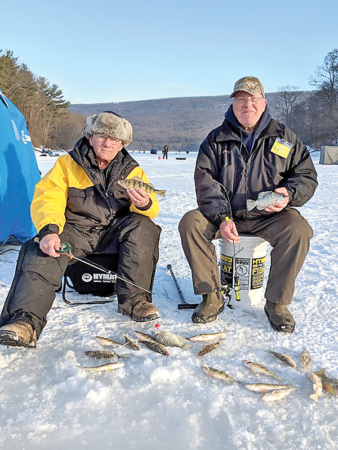I know a lot of people aren’t excited about the cold temperatures, but the “walk on water” gang has welcomed the arrival of winter and the ice-covered lakes. Judging from the 75 plus ice-fishermen prying the depths with jigging rods and tip-ups where I was located; this past weekend was the grand opening of the ice-fishing season. I talked with a number of my old ice-fishing buddies and found men, women and even some children out in full force-some apparently new to ice-fishing.
Ice fishing is far more enjoyable than most people realize and it’s a relatively easy activity to reach a fairly proficient level; even beginners can put fish on the ice. My usual advice is when new to the activity is to go with someone who knows the ropes; after a couple of sessions, you may be ready to try it on your own. Always remember-safety first; don’t assume all ice is safe everywhere. Dress for the occasion, and that often includes wearing a pair of ice cleats.
If you are new to the activity a simple plastic sled loaded with something to sit on, a couple of ice-fishing rods, a scoop to clean the hole and some hot chocolate and you can probably get by. If you can add an ice auger to that list all the better but most experienced ice-fishermen are willing to poke some holes for you, or you can often find some abandoned holes. The advanced gear, like power augers, fish locators, heaters and ice shelters can be added as you go along.
With all the gear we ice-fishermen have available to us these days probably the most important item is the fishing rod; that piece of equipment that is used to make the final connection to the fish beneath the ice. While it’s the most important, it may also be the simplest and least expensive. My first ice rod in the 60s was a chunk of broom handle with a two-foot long piece of a broken spinning rod inserted; the reel was a three dollar plastic reel-I’m still using it today. There are a number of different types of rods and reels available to today’s ice-fishermen, and most are relatively inexpensive, and they all get the job done.
Probably more important is how the rod is used. I keep things on the ultralight side when I’m going after panfish like crappies, bluegills, and perch. Two to four-pound test fluorocarbon is my usual rig with a tiny ice-fishing jig at the business end. I tip the jig with some kind of bait; more often than not that will be a wax worm but maggots, mealworms, and even red worms will also produce. This past week myself, my wife, brother, son and ice-fishing friend Ed Ott all hit a local lake resulting in a good opening day. Any jig with bright green in it seemed to garner strikes.
If you are new to the ice jigging technique you might want to add a tiny bobber once you determine the depth you want to fish; even the slightest movement of the bobber can signal a strike so don’t just wait for it to pop under. Many of us will often fish without a bobber as well, and with this technique, you must “feel” any light taps and set the hook. Something else I often do to increase the action is to add another jig about a foot and a half above my terminal jig, this way I’m actually fishing at two different depths at the same time. Last week I set the hook on a strike and pulled two fish up through the ice-one on each jig; that happens several times each year.
Come on out and join the rest of the hard water walkers-you might be surprised how much fun it can be.





Leave a Comment
Your email address will not be published. Required fields are marked with *